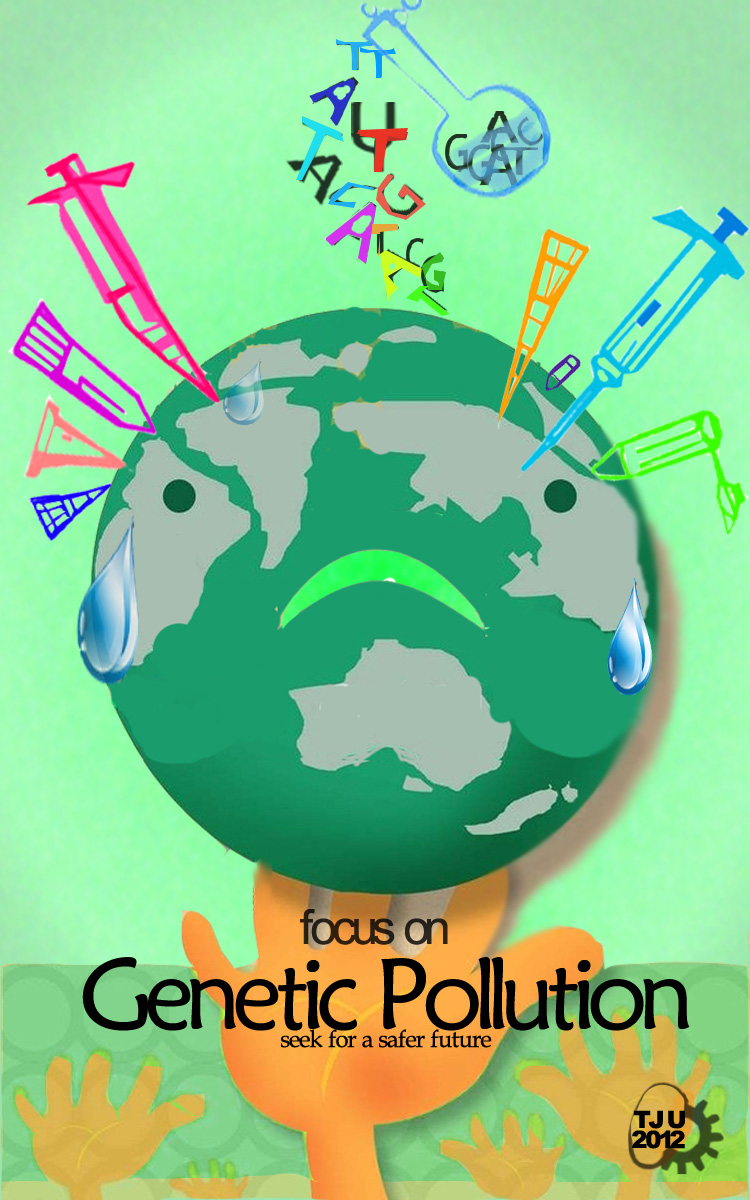Team:Tianjin/Project/Gene
From 2012.igem.org
(→Pollution Prevention) |
(→Pollution Prevention) |
||
| Line 121: | Line 121: | ||
===Pollution Prevention=== | ===Pollution Prevention=== | ||
| - | [[file:TJU2012-Proj-SE-fig-2.png|thumb|300px| | + | [[file:TJU2012-Proj-SE-fig-2.png|thumb|300px|right|'''Figure 3.''' Logo of TJU iGEM Team 2012 (from TJU iGEM Team 2012)]]Biologists across the globe have proposed various solutions to conquer genetic pollution, such as kill-switch. These approaches have their advantages in one way or another, but certain defects too. In this year's project, we come up with a distinctive thinking. We want to construct a new system of orthogonal transcription-translation network, i.e. O-Key. Any genes in O-Key cannot be expressed in normal environment, and then decomposed. In this way, the O-Key can prevent the horizontal gene transfer. In our project this year, we propose several methods to construct orthogonal creature, the phages, such as T7, and φX174. What is more, we have begun to execute the plan of creating the orthogonal φX174. Although this is just a beginning, the future of orthogonal organism and O-Key is sure to be promising. |
=Principles= | =Principles= | ||
Revision as of 21:24, 26 September 2012

Contents |
Background
Genetic Pollution
Genetic pollution is the term of genetics in which the genetic information is transferred in to the organisms where it is not needed or where this information never existed before. This flow of genetic information is usually undesired and cannot be controlled. The flow of genetic information usually takes place between the genetically modified organisms into the organisms which are not genetically modified.
Genetic pollution occurs when domesticated or genetically engineered species interbreed with their wild cousins, thus polluting the wild species gene pool. It is seen as negative because it affects the wild population's evolved capability to survive, as well as spreading genes that are not found in nature.
One of the main issues of genetic pollution lies in the fact that man has tampered with the genetic structure of these species and has created a situation that would not be found naturally. Some people find no issue with genetic pollution however, stating that it is the natural course of events. One thing is certain, genetic pollution irrevocably alters a species, for better or worse.
Genetic pollution doesn't exist in theories or novels anymore. It is happening in our world. For example, "gold rice" event in China where genetically engineered rice with β-carotene was fed to children for research recently attracted people's large attention. The serious situation calls for new way to prevent genetic pollution.
Genetic Encryption
In the information time, data encryption have always been a vital part of commerce, informatics and Internets. It has become a major research and investment field.After the establishment of DNA double helix model, scientists have always been trying to store data through gene. Just as other forms of information flows, if we want to communicate through gene, we have to encrypt and decipher. Many scientists developed some other methods to encrypt in gene. For example, some researchers thought of encrypting through specific inducer. Only adding this inducer, the cell could transcript the gene and express the stored information. Here we offer one new method to encrypt through orthogonal system, and it works well.
Pollution Prevention
Biologists across the globe have proposed various solutions to conquer genetic pollution, such as kill-switch. These approaches have their advantages in one way or another, but certain defects too. In this year's project, we come up with a distinctive thinking. We want to construct a new system of orthogonal transcription-translation network, i.e. O-Key. Any genes in O-Key cannot be expressed in normal environment, and then decomposed. In this way, the O-Key can prevent the horizontal gene transfer. In our project this year, we propose several methods to construct orthogonal creature, the phages, such as T7, and φX174. What is more, we have begun to execute the plan of creating the orthogonal φX174. Although this is just a beginning, the future of orthogonal organism and O-Key is sure to be promising.Principles
Preventing Genetic Pollution and Genetic Encryption
In order to express a certain gene in an orthogonal transcription-translation system, we need both the o-ribosome and o-mRNA to form the O-Key. We are able to rationally design the SD sequence of an mRNA, to make it inscrutable to canonical ribosome. In the meantime, a plasmid manufacturing orthogonal ribosome can be transformed into the cell to help express the o-mRNA: just like a key opens a lock. This mechanism is highly effective in controlling protein expression.
What if we want to limit the expression of certain protein? What if we need to accurately regulate the expression under certain circumstances? The O-Key offers us a great choice. We can put an o-RBS to any gene that codes for hazardous protein. By controlling the existence of the O-Key, we can precisely control the expression of this protein. In this way, the synthesis of dangerous proteins can be strictly restricted and controlled by O-Key, thus preventing genetic pollution. The O-Key serves as a safe to contain
To take one step further O-Key can be applied into biological product. Say we are a pharmaceutical company, and we have a brand new bacterium that can produce an antibiotics. We want to lease bacterium to some companies, but we don't want them to resell it or spread it out. In order to protect our intellectual property, we can use a new encryption technology using the O-Key.
The RBS of the mRNA of some essential protein that sustains cells' life are switched to O-Lock, and we embedded the gene that manufacture O-Key in the cells to decipher the O-Luck. However, the gene for O-Lock needs special inducer. Thus, our company needs to constantly provide the inducer when the contract is valid. The inducer will result in O-Key. Together with the O-Lock, they serve as the O-Key System to produce the essential protein that sustains cells' life. When the contract expires, we'll stop providing the inducer, and the bacteria will stop manufacturing the antibiotics.
As demonstrated previously, we can use the O-Key System to restrict genetic pollution, and construct an encryption system that protects intellectual property.
Constructing the Orthogonal Phages
If we could apply the O-Key System to one particular regulation. Why can't we apply it to the entire organism? At first, we wanted to build a fully orthogonal cells. But minimal genome for a cell is more than 300, which is obviously beyond our abilities. Therefore, we chose phages as the creature we work on. The reason why we choose phages are mainly based on its simple replication process and relatively small genome.
However, different phages have different genome, so we should adopt different methods. For the phages with large genome(more than 20kb), we could divide the whole genome into several little parts, mutate the genome one by one and then assembly with "Yest Assembler". For the phages with small genome, we could mutate the gene directly or firstly divide the genome into small parts and then assembly in Gibson assembly method. As the mutation methods are all site-specific mutations, we just take φX174 as an example.
We will mutate the genome one by one. Once we mutate one gene, we will transform the mutated phage DNA into orthogonal and normal cells to check whether the phage could still replicate, which is revealed by phage plaques. For the overlap gene in the phage DNA, if mutated RBS does affect other genes, we will put this gene before gene A and close the original gene by changing its start codon.
For the limited time, we just plan to construct fully orthogonal φX174. Why we choose φx174 are based on following facts.
- The first creature that was sequenced whole genome;
- The second artificially synthesized viral;
- We have knew clearly about it(if searching in goggle scholar, articles>300);
- The replication process is simple and clear.
- The genome is small, containing only 11 gene.
- φX174 will not affect the common E. coli.
Experiment
Ampr RBS Mutation
We used the orthogonal principle described in the previous section to mutate the Ampr RBS, and constructed an orthogonal transcription-translation system that is independent of the existing system.
The SD sequence of Ampr RBS is GAGAAA, and we rationally designed the orthogonal sequence to be GTTCCG. We further mutated the Ampr RBS of the RFP operon, and transformed plasmid into E coli.
Here, we chose two distinct competent cell: the normal competent cells; the orthogonal competent cells containing o-16S rRNA, and plate the cells on Amp LB plates. As we can predict, the normal competent cells would not be able to express the Amp resistance protein, thus cannot survive. On the contrary, the orthogonal cells can resist Amp in the plate and express the RFP.
Process
- Using PCR to mutate 16sRNA on the P15a plasmid to get the mutated P15a with O-16sRNA.
- Changing RBS of Ampr gene on PBR322 to O-RBS.
- Cotransfomating the above two mutated plasmids into cells, plating Amp LB plates, cultivating for 12-24hours.
Both of the plasmids used above contain the RFP gene to display the results and the Pbad promoter induced by Ala; only if Ampr gene could be expressed, cell will reproduce, RFP gene be expressed and the colony turned red.
Results
From the two flats, we could easily find that the left plant plated without Ala,which means cells only containing normal ribosome. There is no colony on the plate. The reason is that without no orthogonal ribosome, Ampr gene could not be transcripted and translated,then cells could not survive on LB flat with Amp. On the other hand, the right flat, added Ala, containing orthogonal ribosome, have red colonies. Existing orthogonal ribosome means that cells could transcript and translate the Amp r gene, survive in Amp situation, the RFP could also be expressed with the help of normal ribosome.
Plan of φx174
When dealing with phage experiment, many teams will face a difficulty when the phage infect other bacteria.
As for the limited time, we just do some preliminary experiments and design the primers needed for latter work.
Model
Prospect
Some people say that 21 century is the bio-century. With the full development of biology, genetic pollution will be a topic that could not be avoided in future. Some method on preventing genetic pollution will receive more and more attention. Our O-Key System, for its robustness,universality,is simple and effective. In the near future, the O-Key System will play a vital role in genetic pollution prevention. What is more, the O-Key System also works well in genetic encryption. Today, we are facing a world, full of information. Of all the parts of statistics flow, data encryption is an essential fragment. Orthogonal encryption system provide a good method to mask information. To our pleasure, we have been contacting with some related companies for application and received some good results. We have confidence that such a system will achieve a good success.
Finally, we all think building orthogonal creature is a perfect idea. Since we could put orthogonal system in one regulation, why don't we apply it to the whole cell. Just as J C Venter. Other scientists all focused on assembly of a small gene, but he assembled the whole genome of bacterium Mycoplasma mycoides. When we use the orthogonal phages, they could not affect normal cells. Phage pollution is usually common condition in laboratory and need several weeks to disinfect. Orthogonal cells have great advantages in real practice, such as more easily adjusted,never polluting normal cells. We believe that in the future, more orthogonal creatures will be built, and then construct an indispensable system, separate from existing translation and transcription system. Such a system, for its advantages, is more suitable for application in industry and research, blocking the possibility of genetic pollution. However, admittedly, building up such a huge system still require a lots of time and source, we have faith such day will finally come, when real orthogonal system is set up.
 "
"






















